Many people struggle to find suits that fit perfectly. Off-the-rack options rarely match unique body shapes or style needs. Shoppers often feel disappointed when their clothes fail to look or feel right. The frustration grows when they waste time and money on repeated tailoring.
This problem can make shopping stressful. It is discouraging to settle for good enough when you want to look your best. Suits that do not fit well can hurt confidence and leave a poor impression. The answer is simple: bespoke tailoring offers the perfect solution for a truly personalized fit and style.
This custom process creates clothing tailored to your exact shape and preferences. You get results that no ready-made suit can match. This blog will guide you through how bespoke tailoring shops can solve your fit and style issues easily.
Key Takeaways
- Bespoke tailoring shops create custom garments using precise body measurements, hand-sewn techniques, and multiple fittings for a flawless personal fit.
- These shops offer a wide selection of high-quality, often sustainable, fabrics like wool, linen, and cashmere for personalized style.
- Modern bespoke tailors blend traditional craftsmanship with technology, using tools like 3D body scanning and digital mockups for design previews.
- Customers can customize details such as lapel width, pocket style, lining, buttons, and add monograms or unique embroidery for a signature look.
- Many bespoke tailoring shops prioritize eco-friendly practices, including ethical sourcing, waste reduction, and the use of organic or recycled materials.
The Art of Bespoke Tailoring
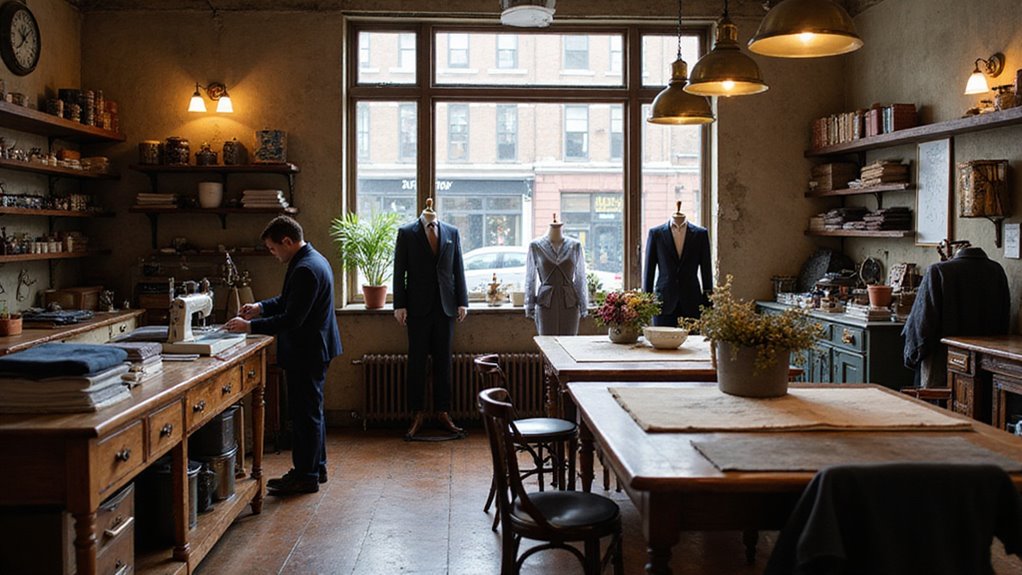
Bespoke tailoring is about making clothes just for you. Tailors use your measurements to create a unique paper pattern. They pick fabrics carefully, often choosing sustainable options for quality and the environment. Each garment is sewn by hand and adjusted during several fittings.
If you want a perfect fit, digital tools like 3D scanning can help. These tools make patterns more accurate and changes easier. If you value tradition and modern methods, bespoke tailoring combines both.
This process gives you clothing that matches your shape, style, and values. Many modern tailoring shops now use professional suit mockup technology to digitally experiment with styles and colors before committing to fabric, ensuring greater satisfaction and resource efficiency.
For those interested in visualizing custom designs beforehand, clothing mockups in Photoshop allow tailors and clients to preview artwork and textures, improving decision-making and reducing production risks.
A Brief History of Tailoring Excellence
You’ll trace custom tailoring back to the guilds of 17th-century London, where cutters and coat-makers established the foundations of hand-crafted garments. Over time, master tailors refined their methods, introducing innovations like full-canvas construction and precise hand-basting.
This evolution in technique and craftsmanship set today’s gold standard for sartorial excellence in tailored shops worldwide. Dress shirts and vests have become versatile staples in men’s fashion, offering timeless appeal and adaptability across seasons and occasions.
Today, modern bespoke shops often utilize high resolution quality mockups to visualize designs before crafting the final garment, ensuring both tradition and innovation are at the heart of tailoring excellence.
Origins of Bespoke Tailoring
Bespoke tailoring began in the guilds of medieval Europe. Its true form took shape in 17th-century London on Savile Row. Master tailors there used hand-drawn patterns and careful fittings. They made jackets with precise shapes and strong structure. Every suit showed careful skill and attention to detail.
If you visited then, you would see vintage styles and elegant fabrics. Over time, famous people and royalty chose bespoke tailors for special clothing. The word “bespoke” means the clothing is made for one person. A bespoke suit is more than clothing; it shows tradition and craft.
Evolution of Tailoring Techniques
Tailoring techniques have changed over time to improve fit and quality. Early tailors used hand-cut patterns and basted fittings for accuracy. Later, they added shoulder canvassing and floating linings for comfort and structure. Today, digital tools help measure and cut fabric with high precision. Eco-friendly fabrics are often chosen to protect the environment.
| Technique | Key Advancement |
|---|---|
| Hand-cut Patterns | Creates a precise fit and custom shape |
| Shoulder Canvassing | Gives natural movement and better structure |
| Digital Tailoring | Uses 3D scanning for accurate measurements |
| Eco Friendly Fabrics | Uses organic or recycled materials |
Modern tailoring combines traditional skills with new technology for better results and sustainability.
How the Bespoke Process Works
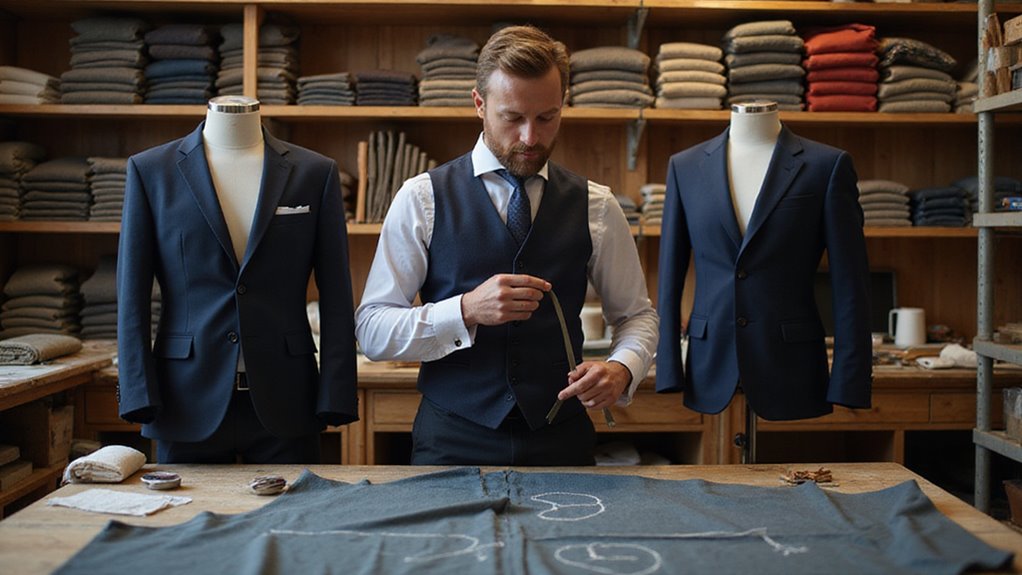
The bespoke process starts when you enter a custom tailoring shop. You first choose your fabric from several swatches. These fabrics include wool, linen, and cashmere. Next, you select style details like lapel width, pocket shape, and button placement.
The tailor then takes more than thirty measurements of your body. They note details like your posture and shoulder shape. If you have special needs, the tailor will adjust for them. A paper pattern is made just for your body. This pattern is placed on your chosen fabric and cut out. Tailors then sew the pieces together loosely for a first fitting. You try on the garment and suggest changes if needed. Several fittings may follow to perfect the fit. The final suit is finished by hand and made to match your exact shape.
In recent years, some bespoke shops have begun offering digital tuxedo mockup services to give clients a virtual preview of their suit, allowing for greater confidence and creativity in the design process. Some bespoke shops now use visual mockup templates to help clients preview fabric combinations and design details before the first fitting.
Key Differences Between Bespoke and Made-to-Measure
Bespoke and made-to-measure tailoring differ mainly in how the garment is made and fitted. Bespoke tailoring creates a unique pattern for each customer using their exact measurements. The tailor adjusts the garment through multiple fittings, ensuring a precise fit.
Bespoke pieces often include hand-finished touches and exclusive details. If you want more choices in fabric and style, bespoke offers greater flexibility. Made-to-measure uses a standard pattern that is changed to fit your measurements. This method usually involves fewer fittings and less customization.
Bespoke tailors often have advanced training and certifications, drawing on traditional craftsmanship passed down through generations. Some bespoke shops also offer luxury accessories, like handmade ties and cufflinks, to complete the experience. When choosing a bespoke shirt, it’s important to consider proper washing techniques to maintain the quality and longevity of the fabric.
Choosing the Right Fabric and Materials
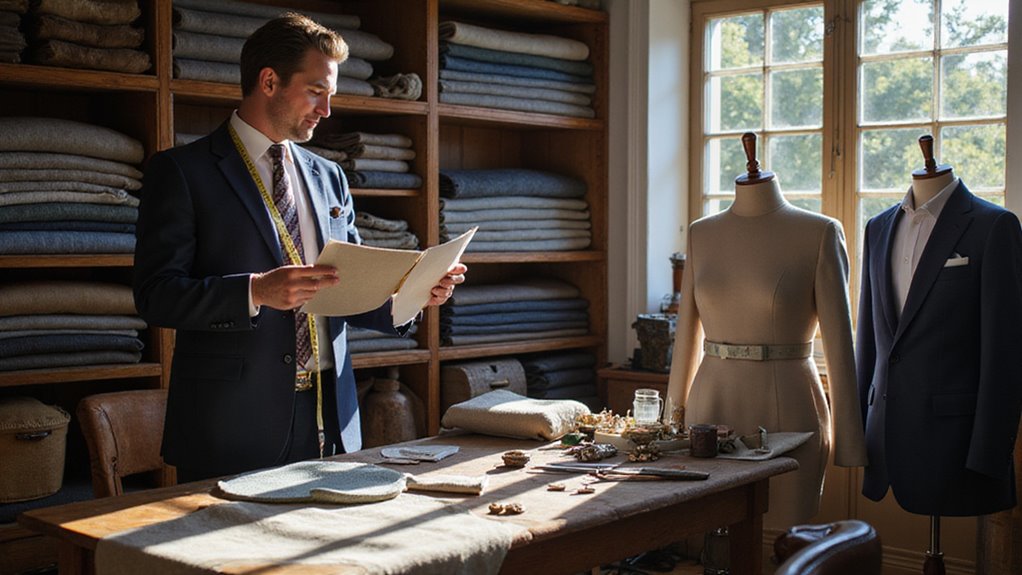
Choosing the right fabric and materials is key to making a comfortable and long-lasting custom garment. Each fabric has its own look and feel. Wool is strong and works well all year. Cashmere is very soft and keeps you warm. Linen is light and cool for hot weather.
Sustainable fabrics like organic cotton or recycled wool are better for the environment. If you want easy care, choose durable blends. For those seeking a personalized fit, it’s important to remember that the fabric you select plays a significant role in how well the garment is tailored to your measurements.
Always check how the fabric feels, what it is made of, and how heavy it is. Your fabric choice will affect how the garment looks, lasts, and feels. For even more personalization, consider selecting custom suit linings to showcase your unique style and add a touch of character to your tailored garment.
The Importance of Fit and Measurement
You’ll notice that true custom tailoring starts with exacting body measurements, capturing nuances like shoulder slope and posture. This precision shapes the garment’s silhouette, ensuring clean lines and flawless drape. When your suit fits with technical accuracy, you project confidence and ease in every movement.
Taking the time for professional suit measurement helps guarantee accuracy and allows for personalized adjustments that enhance both fit and comfort. For the best results, understanding common body shapes helps guide style choices that highlight your best features and create a truly flattering custom fit.
Precision in Body Measurements
Precision in body measurements is important for custom tailoring. Every person’s body is different, so accurate measurements are needed. A tailor uses special tools like a measuring tape to record your body’s size and shape. These details guide the making of your custom clothing.
- Tailors measure your chest, waist, hips, and inseam.
- They consider your posture, shoulder shape, and arm length.
- Adjustments are made if you have any body differences.
- Measurement steps change based on the garment type.
If you want a perfect fit, this careful process is necessary.
Impact on Garment Silhouette
Accurate measurements shape the way a garment fits your body. They decide how the fabric hangs and follows your outline. If a tailor measures your chest, waist, and shoulders carefully, the garment fits smoothly. Incorrect measurements can cause wrinkles or tightness.
Proper sleeve length keeps the garment looking neat from shoulder to wrist. Each body is different, so tailors adjust for small differences, like uneven shoulders. These adjustments help the finished piece look balanced and clean. If measurements are precise, the silhouette will match your natural stance. This makes the garment flattering and comfortable.
Enhancing Wearer Confidence
A well-fitted garment improves how you look and feel. It matches your body shape and supports good posture. If a tailor uses precise measurements, the clothes fit better and look neater. Each seam and dart shapes the fabric to your size. When you move, the garment stays comfortable and keeps its shape. Certified tailors know how to match fabric strength with your body’s needs. They choose durable materials to keep clothes looking sharp over time.
- Accurate measurements give a smooth and neat outline.
- Certification shows a tailor has proper training in custom fits.
- Strong fabrics help clothes last longer and keep their shape.
- Good fitting lets you move easily and feel relaxed.
If you invest in custom tailoring, you may feel more confident and comfortable every day.
Signature Styles and Customization Options
Each tailoring shop offers its own unique style. Shops provide many ways to customize clothes to your taste. You start by choosing from fabrics like merino wool or silk blends. These options vary in feel, look, and durability. Shops use skilled techniques such as hand-stitched lapels and working buttonholes.
These details help your clothing stand out. Understanding the proper fit and length of a dress shirt is essential, as expert tailors will ensure the shirt covers the waistband and stays tucked while still allowing comfortable movement.
Personalization options include fit, lapel width, pocket style, and lining fabric. You may add a monogram or pick contrasting thread. If you prefer, you can choose horn, mother-of-pearl, or metal buttons. Each choice ensures your garment matches your style and the shop’s quality. This process gives you a unique and well-made piece.
Many bespoke shops now incorporate functional features like moisture-wicking fabrics and UV protection, allowing custom garments to blend style with modern comfort.
The Role of the Master Tailor
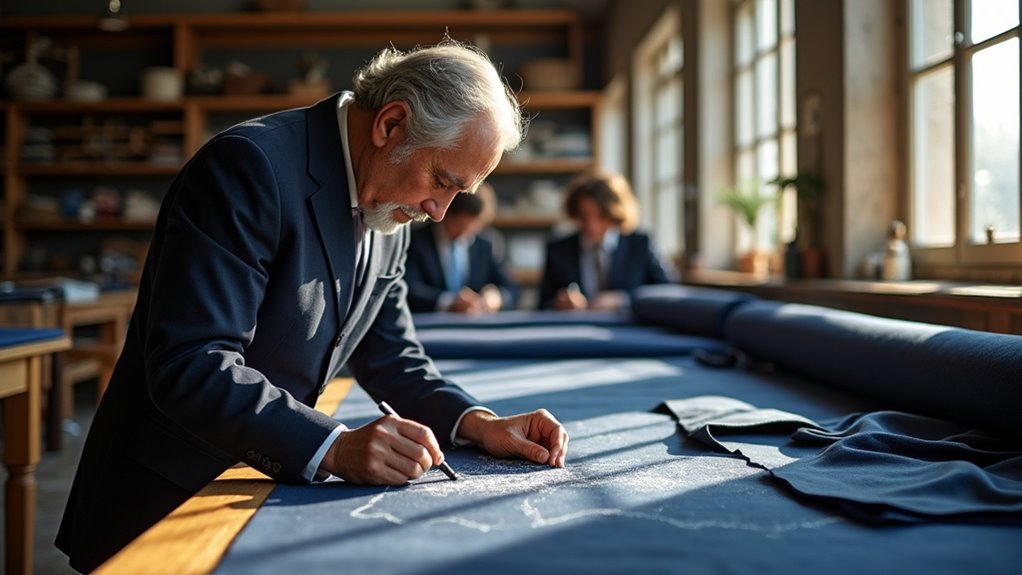
The master tailor oversees the entire custom tailoring process from start to finish. This expert checks fabric quality and helps choose the right materials. Measurements and style preferences are reviewed to create a good fit. The master tailor uses both modern and traditional methods to make each garment. Small mistakes are spotted and corrected at every step.
- Fabric quality is checked and materials are chosen carefully.
- Patterns are made and adjusted for the best fit.
- Hand-stitching and important details are supervised.
- Final fittings are managed, and changes are made if needed.
If you want a well-made, lasting garment, a master tailor will guide the process. When creating or repairing a jacket, the master tailor pays special attention to preparing the jacket for lining to ensure the finished piece is both comfortable and durable.
Timelines and What to Expect
After your design choices and measurements are confirmed, you can expect a clear process and timeline. The custom tailoring process has several stages to ensure a perfect fit. First, you choose the fabric, discussing materials, weave, and color with the tailor. Pattern drafting and fittings follow, where your input shapes the final result. Here is a typical timeline for bespoke tailoring:
| Stage | Duration | Key Activities |
|---|---|---|
| Initial Consultation | 1 hour | Discuss design and select fabric |
| Pattern Drafting | 2-3 days | Create a custom pattern |
| Fittings | 2-4 weeks | Attend basted, forward, and final fittings |
| Final Delivery | 1 week | Complete quality checks and receive garment |
If you have questions, the tailor can provide updates and answer them at each stage. Expect careful attention to detail in every step.
Investment Value and Longevity
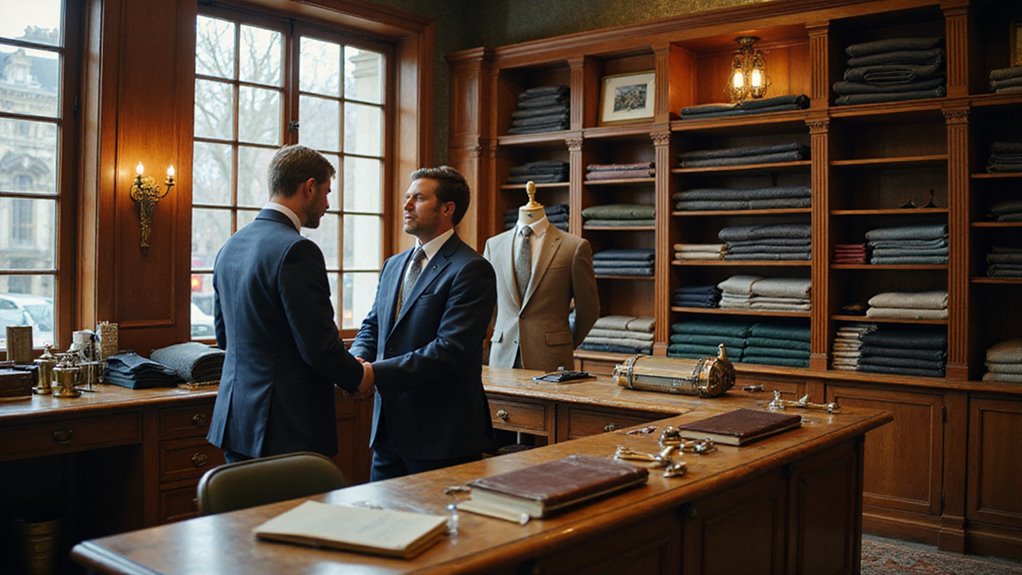
Custom tailoring is a smart investment because these clothes last longer than ready-made ones. Skilled tailors use better materials and careful methods. If you pick a made-to-measure shop, you get clothing built to last. Each piece has strong seams, detailed finishes, and good linings for extra durability. Bespoke garments keep their shape and style, even after years of use.
- Superior fabrics help clothes resist wear and tear.
- Hand stitching keeps garments strong and easy to alter if needed.
- A custom fit reduces stress on fabric, so clothes hold their shape longer.
- Classic designs keep the look stylish for many years.
You get long-lasting value and lasting style from custom tailoring.
Bespoke for Women: Expanding Horizons
You’ll notice custom tailoring for women now challenges traditional gender constructs, offering precision pattern drafting that celebrates every silhouette. Expert cutters and fitters measure, sculpt, and adapt garments to your unique proportions, ensuring seamless integration of personal style and comfort. This approach empowers you to commission pieces that reflect individuality, rather than conforming to industry templates.
Breaking Traditional Gender Norms
Custom tailoring is no longer just for men. Many tailors now make clothes for women with the same skill and care. These tailors break old gender rules by designing clothes for anyone who wants them. If you visit them, you can get jackets, trousers, or vests that match your own style and needs.
Design consultations focus on your personal taste, not on what society expects. Skilled workers use special techniques to make sure your clothes fit well. Fabric choices include both classic and modern options, giving you more variety. Details like buttons and pockets are chosen based on your preferences.
Embracing Body Diversity
Personalized tailoring shops solve the problem of limited sizes in regular clothing stores. Custom tailors use your own measurements, not standard size charts. They design clothes that fit your body exactly. Every seam and detail is placed to match your shape.
If you have unique features, tailors adjust the clothing to fit you better. This approach makes everyone feel included and respected. If you are petite, tall, curvy, or athletic, tailors select fabrics and methods that suit you. Each custom piece frees you from one-size-fits-all clothing and celebrates your own shape.
Personalized Style Empowerment
Personalized style empowerment means shaping your wardrobe to match your taste. Custom tailoring lets women choose every detail of their clothing. You can pick fabric, seams, lapel width, and buttons. If you want a special look, you may mix classic and modern styles. Accessories like custom belts or pocket squares add a unique touch.
- If you want texture, select textiles with different weaves or fibers.
- You can choose embroidery or monogramming for a personal mark.
- Garment structure can be changed for the fit and movement you need.
- If you add luxury accessories, your outfit becomes more unique.
Sustainable Practices in Modern Bespoke Shops
Sustainable practices are now common in modern bespoke shops. Tailors choose organic cotton, ethical wool, and recycled fabrics. They work with mills that track where materials come from. Pattern cutting uses fabric efficiently to reduce waste. If there are leftovers, tailors use them for linings or small items.
Eco-friendly dyes, like plant-based or low-impact options, replace harsh chemicals. Water is used carefully during finishing, and only non-toxic cleaners are used. If you want ethical clothing, you can choose shops that follow these steps. This approach lets you support quality fashion and help the environment at the same time.
Notable Bespoke Tailoring Destinations Worldwide
These cities are famous for their unique styles and skills in custom tailoring. Each place has its own special way of making clothes.
- Savile Row, London: This street is known for sharp suits and classic British tailoring. Tailors use strong fabrics and careful stitching.
- Naples, Italy: Tailors here make soft jackets with light fabrics. They use many hand stitches for a relaxed Italian look.
- Paris, France: Paris is famous for high fashion and detailed sewing. Designers focus on elegant shapes and fine finishes.
- Hong Kong: Tailors in Hong Kong are quick and precise. They mix Asian and Western styles for a modern touch.
If you want the best in custom clothing, consider visiting these cities.
Tips for Your First Bespoke Experience
Before your first bespoke suit appointment, know that every choice affects the result. You should learn about fabric types, weights, and weaves. Research helps you explain your likes and dislikes to the tailor. Tell the tailor if you need the suit for work, parties, or daily use. This helps them suggest the best fabric and fit.
Arrive on time, wearing a good shirt and proper shoes. Skip strong scents, as they can stay on fabrics. Be ready to discuss your preferred shape, lapel, and buttons. If you have questions about construction, ask them. You should share your style needs but also listen to the tailor’s advice. If you follow fitting schedules, you will get the best fit.
Conclusion
If you choose bespoke tailoring, you invest in craftsmanship and quality. Every suit involves over 200 precise, hand-finished steps. These details ensure your suit fits perfectly and feels unique.
When selecting your materials, you can choose from high-quality fabrics like Super 120s and above. If you pick your own silhouette and details, your personality will be reflected in the final garment. This process helps you experience a tradition of precision and individuality.
If you want to visualize your design before production, you can use an Apparel Mockup. This tool lets you see your ideas come to life and make changes easily. Try an Apparel Mockup today to start designing your own bespoke suit.

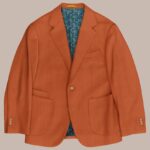

No Comment! Be the first one.